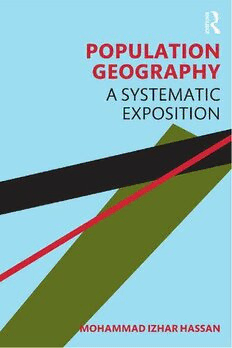Table Of ContentPOPULATION GEOGRAPHY
This book studies the origins and development of population geography as a discipline. It
explores the key concepts, tools and statistical and demographic techniques that are widely
employed in the analysis of population. The chapters in this book:
• Provide a comprehensive geographical account of population attributes in the world,
with a particular focus on India;
• Study the three major components of population change – fertility, mortality and
migration – that have remained somewhat neglected in the study of human geography
so far;
• Examine the salient social, demographic and economic characteristics of population,
along with topics such as size, distribution and growth of population;
• Discuss major population theories, policies and population–development–environment
interrelations, thus marking a significant departure from the traditional pattern-oriented
approach.
Well supplemented with figures, maps and tables, this key text will be an indispensable
read for students, researchers and teachers of human geography, demography, anthropology,
sociology, economics and population studies.
Mohammad Izhar Hassan is Senior Professor of Geography at Maharshi Dayanand
University, Rohtak, Haryana, India. He also served as Professor at Ravenshaw University,
Odisha, India (2014–17), and has been a recipient of the UGC Research Award on a project
entitled Demographic Situation in Odisha and its Development Implication. His research mainly
focuses on population studies in geography. Twelve Ph.D. scholars and seventeen M.Phil.
students have obtained their degrees under his guidance. He has authored four books and
three dozen research papers, published in journals of national and international repute.
He is a life member of several professional bodies/societies including Indian Association
for the Study of Population, Indian Regional Science Association, National Association
of Geographers India, Institute of Indian Geographers, Geographical Society of India and
Eastern Geographical Society.
POPULATION
GEOGRAPHY
A Systematic Exposition
Mohammad Izhar Hassan
First published 2020
by Routledge
2 Park Square, Milton Park, Abingdon, Oxon OX14 4RN
and by Routledge
52 Vanderbilt Avenue, New York, NY 10017
Routledge is an imprint of the Taylor & Francis Group, an informa business
© 2020 Mohammad Izhar Hassan
The right of Mohammad Izhar Hassan to be identified as author of this
work has been asserted by him in accordance with sections 77 and 78 of
the Copyright, Designs and Patents Act 1988.
All rights reserved. No part of this book may be reprinted or reproduced or
utilised in any form or by any electronic, mechanical, or other means, now
known or hereafter invented, including photocopying and recording, or in
any information storage or retrieval system, without permission in writing
from the publishers.
Trademark notice: Product or corporate names may be trademarks or
registered trademarks, and are used only for identification and explanation
without intent to infringe.
British Library Cataloguing-in-Publication Data
A catalogue record for this book is available from the British Library
Library of Congress Cataloging-in-Publication Data
A catalog record for this book has been requested
ISBN: 978-0-367-44066-4 (hbk)
ISBN: 978-0-367-44154-8 (pbk)
ISBN: 978-1-003-00798-2 (ebk)
Typeset in Bembo
by Apex CoVantage, LLC
In the sacred memory of my parents
Mohammad Abul Hassan and
Nazra Khatoon
CONTENTS
List of figures ix
List of maps x
List of tables xii
Preface and acknowledgements xvi
1 Introduction 1
2 Sources of population data 15
3 Population distribution 28
4 Urban–rural distribution 49
5 Population growth 68
6 Age–sex composition 91
7 Literacy and education 120
8 Marital status 141
9 Economic composition 160
10 Fertility 176
viii Contents
11 Mortality and life table 210
12 Migration 242
13 Population theories 274
14 Population–development–environment interrelations 294
15 Population policy 307
Glossary 326
References 335
Index 345
FIGURES
1.1 Trewartha’s triad of geographical elements 4
3.1 Distribution of world surface area (A) and population (B) by
major regions, 2017 35
3.2 Lorenz curve of inequality in population distribution in India,
2011 (based on district-level data of the 2011 Census) 44
4.1 Decadal change in urban and rural population in India, 1951–2011 59
4.2 Rural population by size class categories of villages in India, 2011 60
4.3 Urban population by size class categories, 2011 63
5.1 World population growth (beginning of Christian era to 2015) 71
5.2 Trends in population growth in India, 1901 to 2011 82
5.3 Trends in birth rate, death rate and rate of natural increase in
India, 1901–11 to 2011–16 87
6.1 Age pyramid, India, 1961 and 2011 93
6.2 Trends in overall sex ratio in India, 1901–2011 111
8.1 Marital status of women (age 15–49 years) in India,
2016 (NFHS-4) 151
9.1 Percentage employment in agriculture, industries and services in
the world, 2017 166
9.2 Per cent distribution of workforce in primary, secondary and
tertiary activities in India, 2011 169
10.1 Trends in crude birth rate in India, 1901–11 to 2011–16 189
10.2 Duration involved in fertility transition from CBR < 30
to CBR < 20 191
10.3 Liebenstein’s Model of Fertility Decline 206
10.4 Easterlin’s Model of Modernisation and Family Size 209
13.1 Logistic Law of Population Growth 287
13.2 Demographic Transition Model 291

